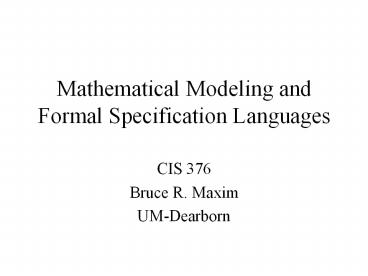Mathematical Modeling and Formal Specification Languages PowerPoint PPT Presentation
1 / 20
Title: Mathematical Modeling and Formal Specification Languages
1
Mathematical Modeling and Formal Specification
Languages
- CIS 376
- Bruce R. Maxim
- UM-Dearborn
2
Mathematical Models
- Abstract representations of a system using
mathematical entities and concepts - Model should captures the essential
characteristics of the system while ignoring
irrelevant details - If model is to be used for deductive reasoning
about the system it needs to provide sufficient
analytic power
3
Mathematical Model Benefits
- Mathematical model is more concise and more
precise than natural language, pseudo-code, or
diagrams - Mathematical model can be used to calculate and
predict system behavior - Model can be analyzed using mathematical
reasoning to prove system properties or derive
new behaviors
4
Types of Mathematical Models
- Continuous Models
- uses calculus and continuous function theory
(e.g. derivatives, integrals, differential
equations) - a function f would define the state of the
system with an infinite number of states and
smooth transitions - Discrete Models
- based on logic and set theory
- state transition functions are used to model
transitions among a finite number of states
5
Discrete Modeling Techniques
- Informal models
- natural language
- charts
- tables
- Structural Models (employ formalisms)
- data flow diagrams
- ER diagrams
- object models
- Formal Models (use formal semantics)
- function models
- state machine models
- formal specification
6
Object Models
- Object models represent systems as structured
collections of classes and object relations - Object models provide a static view of a system
- Some object models rely on a combination of DFD,
ER diagrams, and STD to yield a composite
static/dynamic system model - Object models are structural in nature and can be
useful for creating initial system models that
can be mapped to a formal model if needed
7
Function Models
- Similar to circuit design work
- A logic table for a full adder might be captured
and represented as - Adder(x, y, cinput) (s, coutput)
- ((x y cinput) mod 2, (x y cinput) div 2)
- Also similar to the algebraic specification we
have seen in data type semantic specification
8
Function Modeling ExampleAbstract Stack - 1
- Being by defining stack and element to be
unspecified types - stack TYPE
- element TYPE
- Use a subtype to define a non-empty stack type
- nonempty_stack a TYPE s stack s / empty
9
Function Modeling ExampleAbstract Stack - 2
- Basic operations are defined as functions
- push element, stack ? nonempty_stack
- pop nonempty_stack ? stack
- top nonempty_stack ? element
- Behavior is described by axioms
- Pop_Push AXIOM
- pop(push(e, s)) s
- Top_Push AXIOM
- top(push(e, s)) e
10
Function Modeling ExampleAbstract Stack - 3
- Type checking assures that the expression
pop(empty) is never allowed - The theorem below follows from the type
declarations - Push_Empty THEOREM
- push(e, s) / empty
- The use of subtypes and theorems provides a
powerful tool for capturing requirements in your
type definitions
11
Formal Specification Language
- Based on formal mathematical logic with some
programming language support (e.g. type system
and parameterization) - Generally non-executable models
- Designed to specify what is to be computed and
not how the computation should be accomplished - Most formal languages are based on axiomatic set
theory or higher-order logic
12
Specification Language Features - part 1
- Explicit semantics
- language must have a mathematical basis
- Expressiveness
- flexibility
- convenience
- economy of expression
- Programming language data types
- arrays, structs, strings, sets, lists, etc.
13
Specification Language Features - part 2
- Convenient syntax
- Diagramatic notation
- Strong typing
- can be richer than ordinary programming languages
- provides economy and clarity of expression
- type checking provides consistency checks
- Total functions
- most logics assume total functions
- subtypes help make total functions more flexible
14
Specification Language Features - part 3
- Axioms and definitions
- axioms should be used carefully to avoid
introducing inconsistencies - definitional principle ensures well-formed
definitions - in some languages type checking assertions will
be generated to ensure valid definitions - Modularization
- ability to break specifications into independent
modules - parameterized modules allow for easier reusability
15
Specification Language Features - part 4
- Built-in model of computation
- handles simple type checking constraints
- enhance proof-checking
- Maturity
- documentation
- tool support
- theoretical basis
- specification library availability
- standardization
16
Importance of Type Checking
- Specification languages can have much richer type
systems than programming languages since type do
not have to be implemented directly - Type checking can be used to detect faults and
inconsistencies - Essential model features can be embedded in types
and subtypes
17
System Operations as Functions
- Basic system operations are often modeled as
functions - Functions can modify the system state so
invariant conditions are often imposed on
appropriate combinations of functions (e.g.
similar to algebraic specification) - Theorems and axioms can be used to model other
system invariants employing functions
18
Logical Errors in Formal Specifications
- Logical inconsistency
- Easiest logic errors to detect
- Accuracy
- Does specification match intended meaning?
- System invariants can help in detecting these
errors. - Completeness
- Does specification identify all contingencies?
- Are appropriate behaviors defined for all cases?
- Peer review can aid in detection.
19
Techniques for Detecting Specification Errors
- Manual
- Formal specification inspection
- Theorem proving, proof checking, and model
checking for logic defects - Automated
- Parsing specification for syntactic correctness
- Type checking for semantic consistency
- Simulation or animation based on the specification
20
Formal Specification Process Model
- Clarify requirements and high level design
- Articulate implicit assumptions
- Identify undocumented or unexpected assumptions
- Expose defects
- Identify exceptions
- Evaluate test coverage

